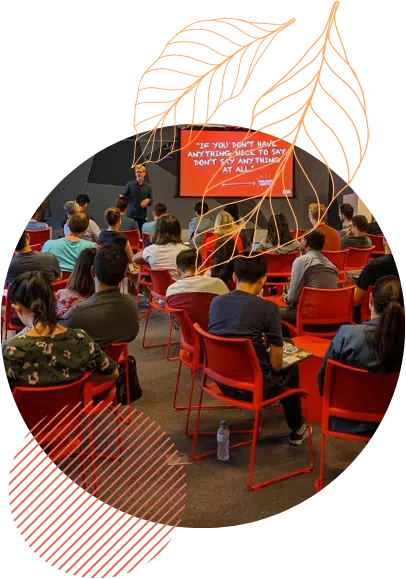Welcome to the itrios Behavioural Assessment
The itrios Behavioural Assessment is a psychologically grounded tool for understanding people’s behaviour in the work place. The assessment consists of questions which deal with a person’s self conduct, approach to tasks, and interpersonal perspective (or Emotional Intelligence), respectively. Since 2000, the questionnaire has become an integral part of ilume’s Developmental Framework within which it is used to interpret the behavioral data output by the questionnaire from an adult-developmental perspective.
The itrios Behavioural Assessment
All people have a list of needs that constitute basic personality traits, such as achievement, affiliation, autonomy, order dominance and so forth.
Everyone has the same psychological needs (Maslow), but not to the same degree. There is a hierarchy of needs unique to each person in which some of the needs are more important than others.
The vertical itrios Behavioural Assessment is based on the notion that the subjective needs of a professional active in an organisational environment are unconscious, or hidden to the individual.
The task of the individual then becomes establishing a livable equilibrium between subjective needs and rational control on one hand, and between rational control and the real world on the other. The emphasis of the itrios Behavioural Assessment falls on the balance of the subjective needs and the perceived pressures the individual experiences.
Using an online questionnaire, a Client Behavioural Assessment provides insight into how s(he):
- The way s/he conducts herself at work
- Approaches Tasks
- Interacts with co-workers and Management
The itrios Behavioural Assessment is comprised of three elements:
- Self Conduct
- A client’s relationship to himself in relation to his or her ego needs, and how that is
experienced within an organisation. - Task Approach
- Providing the clients with an understanding of their work challenges and goals and
- providing them with an awareness of the task focus of the organisation.
- Interpersonal Perspective.
- Interaction with others, asking for help if needed, and affiliating with the organisation, as well as
- how the corporate culture is perceived and actually experienced.
The Behavioural Assessment has been utilised in working not only with individuals and their careers but also with team development and organisational climate change at all levels and all over the world.

Get Started Today
Would you like your team to move to another level.

Integration of the Behavioural Assessment System into a Developmental Framework
Research in adult-development since the 1970’s has considerably broadened the relevance of behavioural data as provided originally by the Need/Press inventory and now the itrios Behavioural Assessment. That research has made it clear that behavioural data needs to be interpreted not only in itself, but also in the context of an assessment of social-emotional meaning making and cognitive sense making.
These two strands of adult development have been combined in the itrios Developmental Framework (IDF). As a consequence, it has become possible for those mastering IDF, to give feedback on how developed (mature) a person presently is, and on whether the two lines of development social-emotional and cognitive — are, or are not, in balance.
At ilume we have learnt how to interpret Behavioural Assessment data in a developmental light. This refines the feedback a person can be given by the user of Behavioural Assessment. The notion is that the itrios Behaviorual profile of a person has different meanings, especially for coaching and development, depending on how advanced a person’s way of making meaning of his/her experiences is, and how developed the person’s thinking is in the journey from logical to holistic and systemic (“dialectical”) thinking.
Background
In the 1930’s a personality theorist at Harvard by the name of Henry Murray presented a list of over 20 needs that he believed constituted basic personality traits. Among these were the needs for achievement, affiliation, dominance, order, understanding, play, autonomy, aggression, and sex. Murray defined a need as a force, located somewhere in the brain that creates tension when aroused. When a need is aroused, the person seeks goal objects that reduce the tension. Individuals learn to associate particular goal objects with satisfaction of particular needs. Thus, one person might call friends to satisfy affiliation needs whereas another might go shopping.
According to Murray, all people have the same basic psychological needs but not at the same degree. Murray proposed that there is a hierarchy of needs, unique to each person, in which some of the needs are more important than others (are prepotent). When these prepotent needs are satisfied, the other needs become more important. He used a variety of methods to measure needs, including self-report, questionnaires, interviews, observation of behavior, and projective techniques. The projective technique he developed is known as the Thematic Apperception Test (TAT), and it has been particularly influential in research on personality and motivation. People are shown a standard set of rather ambiguous pictures and asked to compose stories about them. Their needs purportedly influence the stories they compose (i.e., they will project themselves into the stories). Murray’s theory of needs is one of the psychological theories. His ideas and methods of research are important because of the influence they had on subsequent theorists and researchers.


Behavioural Analysis
The original Behavioural Inventory was constructed by Aderman & Hershenson (1967) and was adopted from Edwards (1957) and Murray (1938). The Behavioural system consists of three objective work related inventories entitled: Individual Needs Analysis Inventory (INAI), Ideal Organisation Climate Inventory (IOCI), and Organisation Climate Inventory (OCI). All three inventories utilize the same 18 variables and each variable contains nine items such that three of them deal with the job setting, (nature of the task), three have to do with interpersonal relations (on the job), and three are benefit-incentive items.
Initial data for all three inventories were obtained on a cross section of successful managers. Obtained scores on the Individual Needs Analysis Inventory (INAI) basically shows the need make-up (temperamental structure) of a manager as he/she relates to the work situation. The pattern of scores (profile) reveals, more specifically, the strengths and weaknesses of the manager in terms of his/her current natural predispositions. Appropriate feedback, especially on the ascertained “short-circuits” will enable the manager’s strengths to come to the fore more readily and to be utilized more appropriately.
The Ideal Organisation Climate Inventory (IOCI) results indicate two relevant bits of information. First, by comparing the obtained pattern of scores with the normative profile of successful managers, the manager’s grasp of organizational functioning is readily ascertained. And, secondly the obtained score on each variable can be compared to his/her score on the INAI. Thus, it is possible to determine the areas where there is appropriate degree of synergism (correspondence) between the manager’s natural inclinations and what he/she deems to be appropriate in a viably functioning organization. Comparing these two sets of scores (INAI vs. IOCI) can also pinpoint the areas of conflict (if they exist) between the reaction tendencies of the manager and what he/she considers to be appropriate in an ideal organizational setting. Conflicts of this sort lead to inconsistent behavior over time. Depending on which is predominate at the moment.
The Organisation Climate Inventory (OCI) portrays the manner in which the manager perceives his/her organization. When data are obtained for his/her particular organization they can be compared to the manager’s obtained scores, thus indicating if there are any gross perceptual distortions. Further, the discrepancy between the cores of the OCI and the IOCI can be examed. Areas of job satisfaction would be indicated by a high degree of congruence between the two scores and similarly variables that show a large discrepancy between the two scores would reveal specific areas of job dissatisfaction. The discrepancy between the OCI and IOCI scores can also be summated over 18 variables to give a single, overall index of job satisfaction (sigma).
Learning to use the itrios Behavioural Framework
In essence, the integrated pattern of scores on the itrios Behavioural profile is a work-related psychological x-ray that objectively depicts the interaction between a manger’s natural proclivities and his/her perception of organisational factors. This, in turn, will enable one to predict a manager’s behavioural manifestations in the setting in which he/she is called upon to function.
The productivity of any organisation is basically determined by the caliber of its management. It is also axiomatic that a manager cannot really manage anything effectively – be it his/her time, his/her subordinates, or even the organisation – if he/she cannot manage himself/herself properly. This is especially critical to realise, since strengths and weaknesses get magnified as one ascends the organisational ladder. Hence, proper self-disclosure is the first, and most basic, step to effective managerial functioning. This is meaningfully accomplished by astute (professional) feedback of the itrios Behavioural profile of the three related inventories. The system is both comprehensive and comprehensible, simple but not simple minded.
Aside from a detached, in-depth feedback session, how else can these inventories be utilised? For one, it can be used developmentally by re-taking the inventories at a later time to determine the impact of the feedback session and any coaching or other interventions that took place in the interim. Applicants can also be given two of the inventories (INAI and IOCI) by which the probability of their success can be determined. Among incumbents, the profiles can be employed as a major thrust is setting up a cutting edge type of succession planning program. Moreover, a profile can be reviewed with the testee’s manager to coach him/her concerning effective ways to deal with and develop his/her subordinates.
Besides developing data for a particular organization to compare it with organizations in general, a “functional analysis” can also be performed on the press (climate) data. This is done by determining the percentage of incumbents who had deviations of three or more between the perceived climate (OCI) and the ideal climate (IOCI) for each 18 variables. This analysis provides information about perceived deficits in the organization or any particular unit or department so that training programs can be tailored to the specific needs of the incumbents. In sum, the itrios Behavioural Assessment is a system that readily addresses a broad spectrum of human resources concerns.

Get Started Today
Would you like your team to move to another level.
